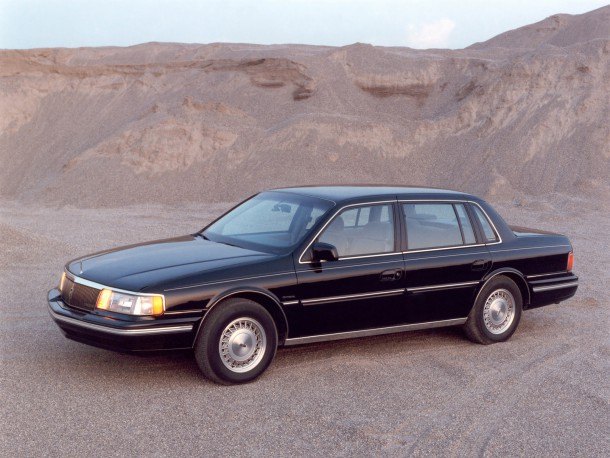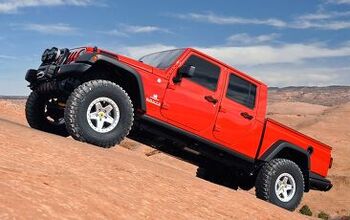No Fixed Abode: I Want To Believe

Three years ago, around this time, I begged the nice people at Ford to build a proper Lincoln. This was shortly after I begged Cadillac to put a V-8 in the ATS. If you put the two articles together, you might get the sense that I have the completely antediluvian mindset that an American luxury car needs a V-8 and rear-wheel drive and main-battle-tank proportions to be completely legitimate. And you would be correct, because that is how I feel and, last time I checked, the nice people at Lexus and BMW and Mercedes-Benz felt the same way because most of the cars that they put on the cover of the Robb Report and the like seem to at least meet those basic criteria.
Well, the spy photos of the new Lincoln Continental are making the rounds. I can see that they have deliberately failed to honor my requests, the same way Cadillac stuck two fingers in my eye by afflicting the ATS-V with the asthmatic blown six when the same-platform Camaro SS has the mighty LT1 from the sublime Stingray. This is a retro Continental alright, but the retro-rockets are only firing back to 1988 instead of 1963.
You remember that 1988 Continental?
It was a spacious, dignified Taurus variant with front-wheel drive, adequate power from the 3.8 V-6, and an emphasis on traditional proportions. I’ve driven a bunch of them — for some reason, they were traded in fairly often on both the Infiniti J30 and the 1996 Ford Taurus, both vehicles for which I happened to be present on the sales floor during their heyday — and you know what, they aren’t terrible. Plenty of room, decent sound systems, low road noise and reasonable ride. What Ford couldn’t quite figure out was how to make them feel luxurious.
Luxury, as we all know, is that immensely satisfying feeling of having more than is required. When it comes to automobiles, however, slightly more is required than the mere presence of excess. We need a certain solidity, a sense of weight, of presence. The mighty Fleetwood Talisman suggested that it could win a head-on collision with a locomotive, but it’s not necessary to have that much size. The original Lexus LS400 wasn’t a large car but it felt as if it had been milled from a single piece of steel then carefully trimmed with leather. The big Volkswagen Group cars, like the Phaeton and the Continental and the A8, have this down to a science, as do both the pre-and-post-W220 S-Class Benzos.
The 1988 Continental, on the other hand, was just a bit too flimsy, particularly when you hit a major pothole and the whole V-6 on its subframe took a fantastic voyage across the relatively limited range of available suspension travel, accompanied by a cacophonous chorus of squeak and creak from every low-grade bolt and bushing ahead of the firewall. That felt Tempo-cheap and, once it happened to you, it wasn’t something that you were ever going to forget for the whole time you owned the car.
The current MKS, which is basically the 1988 Continental just two platforms later, doesn’t have that problem to that degree. What it does have is some genuinely bizarre proportioning and interior arrangements that are a direct consequence of its need to share hard points with the Ford Five Hundred and the Flex. It also has some questionable choices of interior materials, most notably the matte-black panels everywhere that probably looked dynamite in a styling studio but in the real world look like someone’s been rubbing on them just a bit too much when they are new and then look like damaged goods after just a few months in the sun.
Of course, the MKS is still a front-wheel-drive car. After some long and serious thought on the matter, I’ve come to believe that the problem with front-wheel drive in luxury cars is simply the dynamic challenge of controlling all that weight ahead of the front wheels. You could disconnect the rear driveshaft of a 4Matic Mercedes S-Class, or even throw said driveshaft away entirely, and most of the customers would never notice that the motive power was being delivered fore rather than aft. This is true for almost any car where there’s a longitudinally-mounted engine and transmission.
About ten years ago, I took a personal trip to Germany and, while I was there, I drove a V-6 Phaeton for nearly a thousand miles. It was just like my AWD Phaetons, and more importantly it somehow didn’t suffer from that crashy, cheap front-end feeling. The cynical among you might say that, of course, it’s possible to engineer a proper front-wheel-drive luxury car when you have all that money and weight to throw around, but I’d respond by noting that the prices of a V-6 Phaeton in Germany and a Lincoln MKS in the United States aren’t really that far apart once you correct for buying power and the like. No, it’s the north-south engine that works most of the magic. If you don’t believe me, go drive an old Toronado.
If history and early reports are anything to go by, however, this new Continental will be far more platform Issigonis than systeme Panhard (with all due respect to diatribe Torchinsky.), which means it’s starting behind the 8-ball when it comes to over-the-road dynamics and ride control. Still, this is the company that gave us the Boss 302, so I’m not ready to claim that they can’t overcome some inherent disadvantages wherever they might be found. The interior, too, looks about right for the job. There’s a lot of black leather and chrome, just like in the suicide-door spirit animal and nothing like the bland beige rectilinearity that plagued the 1988 model.
It’s the spy shots of the car on the road that concern me. There’s no presence to it whatsoever. Maybe it will be different in the metal, but in photographs it continues to have that MKS-esque dis-proportion of height to length. These proportions work on the Rolls-Royce Phantom, but they don’t work on the Ghost and that’s because you need to have true ocean-liner dimensions to make a car that upright look correct. I don’t think this Continental will be within a foot of even the Ghost in overall length, so the net effect will be a car that gets lost in a parking lot full of Camrys.
I also can’t see how a company that green-lit the stunning Kammback of the MKZ can’t manage to understand the fact that a modern luxury car needs a drooping trunkline and give the Continental a proper one. Even Hyundai understands this. Seriously. Go look at a LaCrosse and then look at an Equus. The difference is the trunkline. And I’m not trying to hold Hyundai up as an example of how to run a luxury brand, but hell, somehow they figured out how to build a full size, V-8, rear-wheel-drive sedan. Apparently, that’s easy for them, but it’s too much for the Ford Motor Company despite the seventy-year head start the latter enjoys in such matters.
With all this said, I’m still going to try to inveigle my way into the media preview of this car. I want to drive it as soon as humanly possible, because I really, truly, want to discover that Lincoln’s finally done it. That they’ve managed to build a car that speaks to the market with at least the authority of the 1980 Town Car, if not the 1963 Continental. That they’ve built a car that feels special, that communicates a true luxury experience. I imagine a world where the country-club parking lots are once again full of Lincolns, where the sight of the crosshair logo inspires respect again. In short, I want to believe. So here’s my final message to Ford on this subject: don’t let me down, okay?

More by Jack Baruth
Latest Car Reviews
Read moreLatest Product Reviews
Read moreRecent Comments
- Dr.Nick The cars seem really expensive with tight back seats and Cadillac was on the list of the highest price gouging dealers coming out of COVID. I don’t understand the combination, shouldn’t they be offering deals if they are not selling?
- Dr.Nick Too bad the Turbo XT isn’t coming. The Outback Turbo is not bad at all, would be a lot of fun in the shorter Forester.
- Dave M. Looking for a cheap commuter economy car, the base Corolla hybrid all the way. Willing to spend more for the toys I like (power seats, sunroof), I'd wait for the Civic hatchback hybrid. The Civic definitely has a nicer interior IMO.
- 2ACL 2.slow + stick + major components serviced = many more miles of motoring if the next owner is even half as diligent. Not my cup of tea, but I could understand someone wanting to take this home.
- AZFelix In related news, the California Department of Public Health in cooperation with CARB is proposing a complete ban on new car sales by 2039. The agency director was quoted as saying "If it prevents just one death..." and "Think of the [non-aborted] children..." at a press conference. The DEA immediately classified Ozium Air Sanitizer spray as a Schedule I chemical/drug and applied for a yearly budget increase of $690 billion dollars to help prosecute their 'war on car freshness'.



































Comments
Join the conversation
The imagery of Lincoln's, specifically Town Cars in the 90's-2000's as being taxis/livery service vehicles I am sure still reeks it's butt from time to time and is part of the reason why nobody truly takes Lincoln serious still. 90's-2000's Town Cars aren't anything special either. Ford was very cheap at platform sharing during this time, worse than GM when compared to the D-B body full sizers. Sure, Town Cars, might have been good cars, but in no way shape or form did they have a high quality interior and the refinements of a Lexus or a Benz of the similar era. Lincoln sure did know how to make comfy good quality seats though! I thought when Lincoln got it's own design studio, President, and staff that was far away from the Ford guys, they would be using more unique Lincoln "exclusive" drivetrain components and other Lincoln only parts within the division. But it looks like Ford is still being Ford, trying to pull off luxury on the cheap. The only way to prove to people that you are taking this game seriously is to go all out and build the greatest if not a better luxury car than it's rivals and competitors, or else don't even bother wasting anyone's time with half ass attempts at being something special. It is mind boggling how Hyundai is able to build the Equus, and Genesis, cars that look decent, are RWD, V8 powered, with an Air Suspension all around (Equus) with rear seat passengers being the primary focus. Yet Lincoln, and even Cadillac have taken so long to respond to what everybody is saying what they need to do in order to become a prestigious legitimate luxury brand again. Ford is too conservative, and has been a very conservative automotive company ever since it's inception. I believe this has a lot to do with their lame, and soft business decisions, even down to the styling of it's cars over the years.
The fact that the Town Cars of the 90's and 00's have been pressed into service as limo/taxis in no way negates the fact that they are in some real senses a luxury vehicle. Nor does the fact that they shared a (very good for the time) platform with Ford and Mercury detract from that. If luxury is the sense of having things that are not essential, but which enhance the experience in noticeable ways, then, as a driver of a Grand Marquis (97), I can say unequivocally that while it may not match all of the finest features of the best ever made versions of say M-B or BMW, it certainly has many features that are luxurious, and those features, plus more (air suspension, for example) are and were present in the Lincoln variant, platform sharing notwithstanding. And though Ford may have pinched pennies at times (de-contenting did as much to kill the Panther platform as anything, except for perhaps the benign neglect it received in its final years in the showroom), Ford has never become the crippled shell of its former self that both GM and Chrysler became. GM and Chrysler both survived primarily as bait/fuel/food for bankruptcy lawyers for years, carrion and incipient carrion for the courtroom process. While Ford may have struck out, for example with the Performance Auto Group concept, they still managed to retain their independence, and have consistently learned from mistakes, and reinvented themselves with new groundbreaking gambits. EcoBoost, aluminum truck bodies and flatplane crank muscle motors being just three such examples. Bball40dtw, who should know, has pointed out that Lincoln cannot or will not produce a RWD sedan before the advent of the D6 platform, which if I recall correctly, he had earlier indicated was due in MY2018. If I were in midcareer, with a full house of family, and looking for an aspirational vehicle, I would be looking forward to see what Lincoln will do in 2018. Call me a Ford fanboi if you wish, but Ford has given me many good reasons over the years to remain a fan, in spite of missteps. Better some missteps than some monumental failures. I'm not going to list all the much greater fubars of the other domestic marques, unless asked or pressed to, but they clearly have fallen down much more and much more deeply, than Ford ever has. My money is on Lincoln pulling off a phoenix-like return to luxury well before 2020. In fact, Lincoln Phoenix wouldn't be a bad name for a RWD Lincoln with a large-V8 or V12 new-style high HP, broad torque motor. Give it decent mpg for a large car, and a zero to sixty time around seven, plus good suspension/handling, and Katy, bar the door.